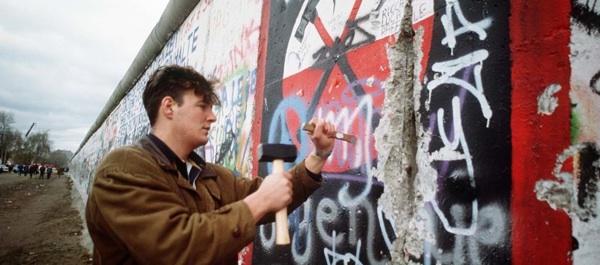The Berlin Wall – Bits and Pieces of History

The iconic symbol of the half-century long Cold War was the Berlin Wall, 96-miles of concrete barrier erected by East Germany’s repressive regime beginning in August 1961 that separated the Free World from the Communist bloc. One of the world’s most heavily guarded borders (192 Germans trying to escape to the West were killed and 200 wounded by East German guards), the Wall was the visible embodiment of the Cold War’s “Iron Curtain” that Winston Churchill famously declared in 1946 had “descended across the continent.” Ronald Reagan’s dramatic 1987 plea to his Soviet counterpart, “Mr. Gorbachev, tear down this wall!,” finally was answered on November 9, 1989 when the crumbling East German regime at last allowed Berliners from east and west to freely cross the Wall’s checkpoints. TV images of Germans hammering at the Wall remain some of the end of the Cold War’s most compelling scenes.
{default} As the world marks the 20th anniversary of the fall of the Berlin Wall, the question arises “What happened to the Wall itself?”
As the world marks the 20th anniversary of the fall of the Berlin Wall, the question arises “What happened to the Wall itself?”
The answer is that parts of the Berlin Wall, bits and pieces of Cold War history, survive across the globe in locations as unlikely as Seoul, Korea. Much of the Wall’s concrete was crushed into gravel to help rebuild German roads, and some complete sections still remain at various Berlin locations. Small pieces of the Wall can be purchased at souvenir shops and from on-line vendors. Larger portions found their way to the U. S. where over 50 sections are on display at various public venues across the country, including Washington, D. C.’s Newseum (largest sections outside of Germany), and the JFK, Richard Nixon, and George H. W. Bush presidential libraries.
Given his famous plea to “tear down this wall!” it seems only natural that plans by the Ronald Reagan Presidential Foundation to renovate the Reagan Presidential Museum in Simi Valley, California (the refurbished museum is set to open on the centennial of Reagan’s birth in February 2011) include a Berlin Wall exhibit.
 Yet, the most dramatic display of America’s Berlin Wall remnants is, appropriately enough, at the Winston Churchill Memorial & Library at Westminster College, site of Churchill’s “Iron Curtain” speech. Artist Edwina Sandys, Churchill’s granddaughter, used eight graffiti-strewn sections of the Berlin Wall to create her dramatic and inspiring, 11-foot-high by 32-foot-long “Breakthrough” sculpture.
Yet, the most dramatic display of America’s Berlin Wall remnants is, appropriately enough, at the Winston Churchill Memorial & Library at Westminster College, site of Churchill’s “Iron Curtain” speech. Artist Edwina Sandys, Churchill’s granddaughter, used eight graffiti-strewn sections of the Berlin Wall to create her dramatic and inspiring, 11-foot-high by 32-foot-long “Breakthrough” sculpture.
The German Embassy in Washington, D. C. maintains an interactive map showing all Berlin Wall locations in the U. S. on its website.
—Submitted from Germany by George W. Albrecht.

